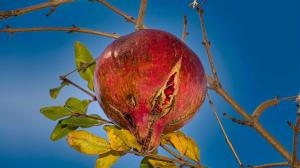Pomegranate Fruit and Boron
Pomegranate fruit is an excellent source of vitamins, antioxidants, and minerals. However, the fruit may lose its quality due to inadequate water and boron.
NEW YORK, NEW YORK, USA, September 12, 2022 /EINPresswire.com/ -- Pomegranate Fruit And MicronutrientsPomegranate fruit (Punica granatum) has been enjoyed in tropical and sub-tropical zones for centuries. The juicy, fleshy arils (seeds) surrounded by fleshy pulp make it a delicious and healthy treat.
The raw pomegranate’s edible portion comprises 78% water, 2% protein, 19% carbohydrates, and 1% fat. Pomegranate sarcotesta contains 12% of the DV (Daily Value) for vitamin C, 16% DV for vitamin K, and 10% DV for folate in a 100 g (3.5 oz) serving. Pomegranate seeds are a great source of dietary fiber (20% DV), which is exclusively present in edible seeds and provides various health benefits.
Pomegranate fruit is an Iranian native and has long been widely produced in Mediterranean nations, including Spain, Egypt, Morocco, and Afghanistan.
It is also produced in Russia, Bulgaria, Southern Italy, Burma, the United States of America, and China. Pomegranates are widely grown due to their adaptability, hardiness, drought tolerance, low maintenance requirements, stable yield, good quality, and medicinal benefits.
Boron, as a micronutrient, is required for plants to reduce fruit cracking and enhance fruit yield and quality.
Studies on Boron and Calcium Foliar Application on Pomegranate Fruit
One study on the use of boron to see the effect of boron on the fruit took 45 pomegranate trees from an orchard in Turkey’s Ortaca region, where the area’s soil was alkaline. These trees were then put in a randomized order in split plots and labeled with plastic tags.
During treatments, boric acid and calcium nitrate were applied at different concentrations. These were used during and one month following full bloom. The treatment was done at noon time with a hand pressure sprayer with a 15L capacity.
To determine the outcome, leaf samples were collected from each tree to evaluate the nutrient concentration, and 9 fruits per replication were chosen to determine the mean fruit weight, length, and diameter.
TARIST analysis was used to measure the effects of calcium nitrate and boric acid on pomegranate fruit quality.
All treatments enhanced fruit weight and size (diameter and length). Additionally, boric acid enhanced the growth due to B’s improved fruit set and retention.
Boron and calcium application enhanced vitamin C concentration. Additionally, boric acid improved the pH, ascorbic acid, total soluble solids, and titrable acidity.
All treatments significantly lowered fruit cracking to enhance fruit yield.
Fruit Cracking
Fruit cracking is a major physiological problem that harms the production of high-quality fruit. Infection by fungi, quick moisture loss, and extreme shriveling result in cracked fruits, lowering market quality and durability. Fruit cracking occurs due to nutritional deficiencies such as boron and calcium, which can be controlled by applying the right amount of their concentrations.
Most fruit crops experience one of three types of cracking: Splitting, Star cracking, and Peel cracking. It can occur in one of three ways: Radial (longitudinal), Transverse, or Concentric.
Other Causes of Fruit Cracking in Various Fruits
Almost all commercially important horticultural crops have experienced fruit splitting or cracking. This condition is common and has been observed in apricots, pomegranates, prunes, and other fruits and vegetables.
Numerous fruits have been thoroughly researched to understand the causes of cracked fruit, and the following are some of the key reasons:
Environmental Factors
Long periods of high relative humidity, specifically when the fruits are just little, may change the cuticle’s composition to the point that it loses its ability to protect.
Excessive water availability and reduced water loss from leaves caused by saturated relative humidity.
During high temperatures and low humidity in the summer.
Biotic Factors
The fruit skin first tears at the weakest spot when there is a physiological disorder or damage from illness, insects, or mechanical trauma.
These diseased tissues contain moisture abnormally when the water supply is abundant and produce rupture through irregular swelling.
Hormonal Factors
Hormones play a significant influence on cracked fruit. Auxins and gibberellic acid are two growth regulators that control fruit cracking.
Managing Fruit Cracking
Fruit cracking is managed using various techniques in various fruit crops, including drip irrigation, mulching, resistant cultivars, bagging, fertilizer management, timely harvesting, different packing materials, and spraying of micronutrients and growth regulators.
Pomegranate fruit cracking is a complicated problem with many possible causes. Recent advances in the research of fruit cracking’s physiology, causes, and successful treatment make it abundantly clear that neither external nor internal variables should be disregarded when tackling the issue. Instead, both must be approached holistically.
Also, the correct application of boron and calcium results in enhanced pomegranate fruit yield, quality, and production.
Brendan McMahon
BORATES TODAY
editor@borates.today
Visit us on social media:
Facebook
Twitter
LinkedIn
Legal Disclaimer:
EIN Presswire provides this news content "as is" without warranty of any kind. We do not accept any responsibility or liability for the accuracy, content, images, videos, licenses, completeness, legality, or reliability of the information contained in this article. If you have any complaints or copyright issues related to this article, kindly contact the author above.

